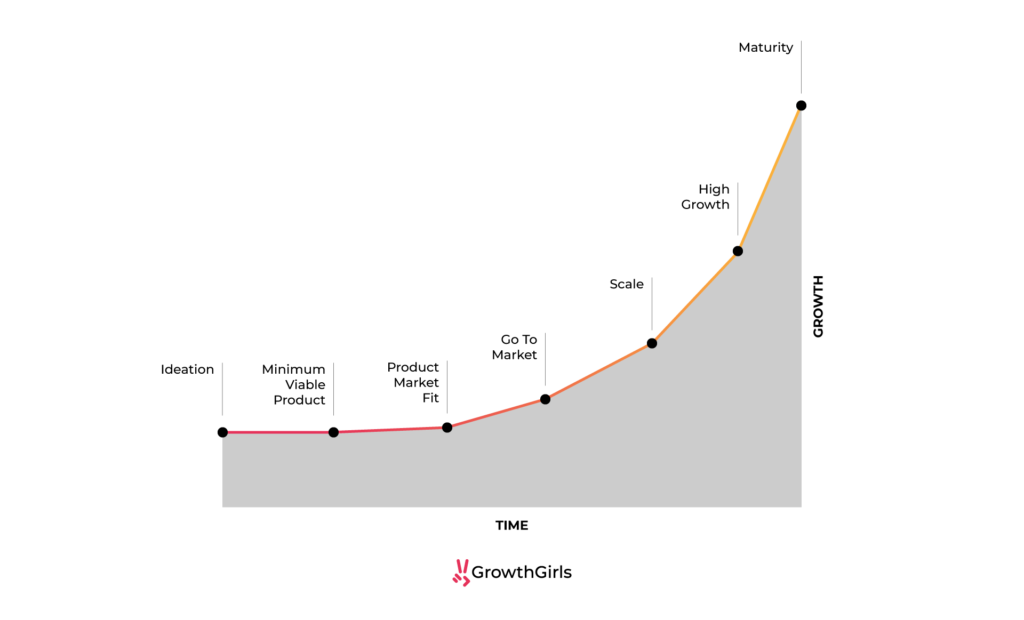Table of Contents
ToggleThe Journey of Startup Growth
We’ve all heard stories of humble startups starting in someone’s garage, later turning out to be today’s most renowned businesses. According to Natwest’s 2023 Startup Index Report, 900,000 new businesses were registered last year, up to 12% more than in 2022. With the rise of technology and the ever-complicated life of the average, modern person, the market’s demand for convenience and advanced solutions to problems is more prevalent than ever.
Entrepreneurship is booming- yet just a good idea is not enough. The sad truth is that 90% of startups fail, 10% of which within the first year, as shared by Failory. Whether the reason is market demand misadjustment, strong competition, user-unfriendly products or poor marketing, one thing is true. Entrepreneurs wishing to start a new business should carefully plan their steps from ideation to go-to-market to avoid common pitfalls, such as trying to scale too fast without the right product-market fit.
To conduct effective market research and move diligently based on data-driven decisions, new entrepreneurs & seasoned entrepreneurs alike, should take notice of the 7 stages of Startup Growth: 1. Ideation, 2. Minimum Viable Product, 3. Investment, 4. Product-Market Fit, 5. Go-To Market, 6. Growth and 7. Maturity.

The 7 Stages of Startup Growth
Ideation
Ah, the “Honeymoon phase”! This is where excitement for the opportunities to come is at its peak. You dream of press releases and interviews on that young entrepreneur that revolutionized…hhhmmm, what exactly? 🤔 You need an idea there, buddy.
So, how exactly do you come up with a million-dollar idea? Simple. You listen and observe everyone around you with intention and empathy. This is when you discover “a problem”. By surrounding yourself with a community, you find a problem that leads you to your product, and later to your business. The “Ideation” stage.
Whether it’s a struggle that no one has tackled before (a little bit unlikely) or an existing solution that could be better, don’t stop until you hear the phrase “OMG, I need this product (solution) right now”! This means you have market potential and can finally build your product hypothesis: “This product or service is a solution to this problem for market Y because of reason X”.
Minimum – Viable Product (MVP)
Once you come up with your hypothesis, you have to test it. A “Minimum Viable Product” or MVP is the quickest and cheapest way to a working prototype. It’s the only sustainable way to measure whether your product has a real market value (remember we discussed startups misjudging market demand) and whether you are using the right channels to reach your audience.
Imagine hiring a pricey team of developers to make an integrated app with all premium features and automation and later, after all that time and cost spent, you discover that your basic premise was not attractive to the market at all. Start small by testing one key feature (your solution) and do most of the work manually.
You don’t need a complex backend or impressive product to follow what’s called the “Build-Measure-Learn-Feedback” loop: 1. Build a prototype, 2. Measure reactions, 3. Learn from feedback & make adjustments, as you go. This is really important and we can’t insist enough, get super-focused on one or two caveats. More points for Gryffindor if your customers are willing to pay for this basic product/service version. It’s never too early to start monetizing and once you have your first cohort of paying customers, you have a strong advantage in attracting investors.
Investment
There are many types of startup funding including venture capital, credit card or short-term loans and the simplest of all-friends, family & personal funding. (But that’s a matter for another article.)
Despite placing the “Investment” stage between MVP & Product-Market Fit, venture-backed startups usually go through a series of investment cycles (pre-seed, seed, A, B, C, etc.), as they grow. The pre-seed and seed investment rounds usually take place in the ideation and MVP phases, given by angel investors, accelerators and specialized funds. You can now use this funding to test your product-market fit and develop your go-to-market strategy.
Series A,B,C, are meant to grow on what’s already working and reach maturity. They fuel your go-to-market efforts and facilitate gaining more market share sustainably.
Product-Market-Fit (PMF)
Reaching the “Product-Market-Fit” or PMF stage is on every entrepreneur’s manifestation board – and within reason! But, let’s start with what it means. Product-market fit describes whether a company’s product or service satisfies an existing market demand. You could have the most amazing product or service but with no market demand, there is no market value. Basically, you place your hard-earned money and time to the chopping block. To achieve success at that stage, carefully assess your market potential. Here’s how:
- Create a “Business Model Canvas” to assess your business’s 9 building blocks.
- Validate your market potential by considering: a) your value proposition, b) your communication channels, c) your target audience and d) your monetization capabilities.
- Conduct 10-minute audience interviews or design surveys to test your market potential criteria.
- Test your MVP, gather audience feedback and add new features as you go. Use a “ Bullseye Framework” to narrow down your communication channels.
- Consider your strategic goals and analyze performance based on related metrics. Use the “AAARRR Framework” to discover which KPIs to look for.
A good measurement of your PMF status is the 40% rule: after completing all the steps, ask your customers if not being able to access your product or service would bring them disappointment. If less than 40% say yes, go back to step 3 and gain additional feedback. Remember, be wary of alternatives that offer more market value.
Product-Market Fit in a nutshell: People are buying as soon as you provide, you expand your business & hire more salespeople. Reporters reach out as they hear the buzz and investors want to know more. (On the contrary, not reaching PMF comes with the sound of crickets…🦗)
Go-To-Market Strategy
Once you successfully implement your product-market fit strategy – and there is in fact market demand! – your next move is to hone your “Go-To-Market” Strategy. Simply put, your goal here is to convert as much of your target audience to paying customers as possible.
If done right, you can now differentiate yourself from competitors while leading to a repeatable, scalable, and profitable revenue generation mode. Ultimately, you need to prove that your startup is bringing in profit by showcasing a positive cash flow. Now, it’s time to compare your customer acquisition cost (CAC) to the revenue each customer brings over time (LTV).
To do so, you need to define the marketing, sales, pricing, and customer retention strategies that keep this relationship healthy while they are not easily repeatable by competitors. Here are 5 tips on how to achieve that (there are many different ways toward startup growth depending on each company’s unique value proposition, business model & processes):
- Develop Proprietary Technology: Owning unique, patented technology provides a significant competitive barrier that is hard for others to overcome.
- Establish a Unique Brand Identity: Building a strong, recognizable brand that connects emotionally with customers can set a business apart in a competitive landscape.
- Secure Intellectual Property Rights: Protecting innovations with patents, copyrights, and trademarks prevents competitors from using your creative outputs.
- Create a Superior Customer Experience: Delivering exceptional service and a memorable journey for customers can lead to loyalty and a distinguished market reputation.
- Invest in Talent and Culture: Developing a company culture that attracts and retains top talent drives innovation and operational excellence, creating a distinct advantage over competitors.
Growth
At the “Growth” stage, you have successfully showcased long-term, sustainable profitability by acing your product-market-fit & go-to-market strategy. You are now part of the 10% of startups that manage to move past the hardest stages of startup growth and prove your scaleability. Yay, you! That’s not an easy feat to achieve. 👏
It’s time to broaden your horizons by considering new markets and geographical expansion. Here, you may need another round of venture-backed financing – including growth equity and private equity firms – to blow the competition out of proportion and move toward maturity.
Maturity
Well folks, seems like we reached the end of the story with “Maturity”. You now have the industry experience to do what you do best: listen to your customers and keep providing solutions to their problems. Another important task is to give back to the next generation of entrepreneurs by giving back to the startup ecosystem as an investor.
You may also be looking for an exit strategy if those criteria apply to you:
- An established, well-defined and successful business model
- Stable yearly profits
- An all-the-way navigated startup growth and expansion strategy
There are many exit strategies to consider like going public, liquidating, selling to third parties or merging with another business. But, that’s also another discussion on its own! 😉
Your Startup Growth Starts Now
Every great business begins with a simple idea, and yours is just waiting to become a reality. Begin by developing your MVP, securing initial funding, and acing Product-Market Fit to ensure your holy grail- market demand!
By following the 6 steps of a successful PMF strategy, you’ll turn potential into profits and customer curiosity into commitment. Remember, get hyper-focused, assess your value proposition, communication channel and profitability and maintain sustainable startup growth with data-driven decisions. Your journey starts today—embrace it and shape the future of the startup ecosystem!
Are you at the beginning of your Startup Journey and need some guidance?
Get in touch with our founder, Effie Bersoux, at [email protected].







